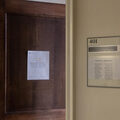Uffizi Gallery conservator to share Michelangelo expertise
Five centuries and an ocean separate Michelangelo’s Renaissance masterpieces from the Syracuse University student body.
Art conservator and SU Abroad adjunct professor Diane Kunzelman will bridge that gap with her guest lecture, ‘Restoring Michelangelo,’ today at 4 p.m. in the Life Sciences Auditorium.
A conservator at the Uffizi Galleries in Florence, which is home to many Renaissance-era artworks, Kunzelman specializes in Michelangelo’s work. She said she hopes to share her insight from more than 40 years of work in the art restoration field.
‘My mission here, in particular, is to communicate all the information about what the work of art is all about,’ Kunzelman said.
Kunzelman graduated from SU in 1967 with a degree in fine arts. She began work in art restoration in the aftermath of the 1966 Arno River flood in Florence, which left many Renaissance-era works damaged. Since then she has worked on many major artworks, including Michelangelo’s David and Doni Tondo.
‘I started actually working in the laboratory with experienced professionals at the time of the flood,’ Kunzelman said. ‘Things have changed today.’
Since the flood, her profession has become highly specialized, especially in Florence.
‘Studying art conservation today is definitely something that you have to face, not just with interning or apprenticing in restoration laboratories, but facing a well-organized course on the graduate level in conservation,’ she said.
In 1988, Kunzelman became an art conservation professor at SU Florence, something she continues to do today.
‘I came back to teaching because it was a way to keep myself updated, which is absolutely fundamental,’ she said. ‘There are a lot of parallels with the medical profession. I don’t think you would trust a surgeon or a doctor who doesn’t continue learning things. And a way to continue learning things is not only reading books, but having contact with young people.’
A New York City native, Kunzelman has lived in Florence her entire professional career and became an Italian citizen in 1972.
‘(It) is submerging yourself in the cultural environment that has produced the works of art that you’re involved with,’ she said.
Though she is surrounded every day by Renaissance artwork, she said the thrill of working with such classic artists as Michelangelo has not diminished, nor has her appreciation of their abilities.
‘Seeing them day after day, each time going past them or taking a look at them under the microscope to observe the brushstrokes is always a new discovery,’ she said. ‘It’s a privilege.’




